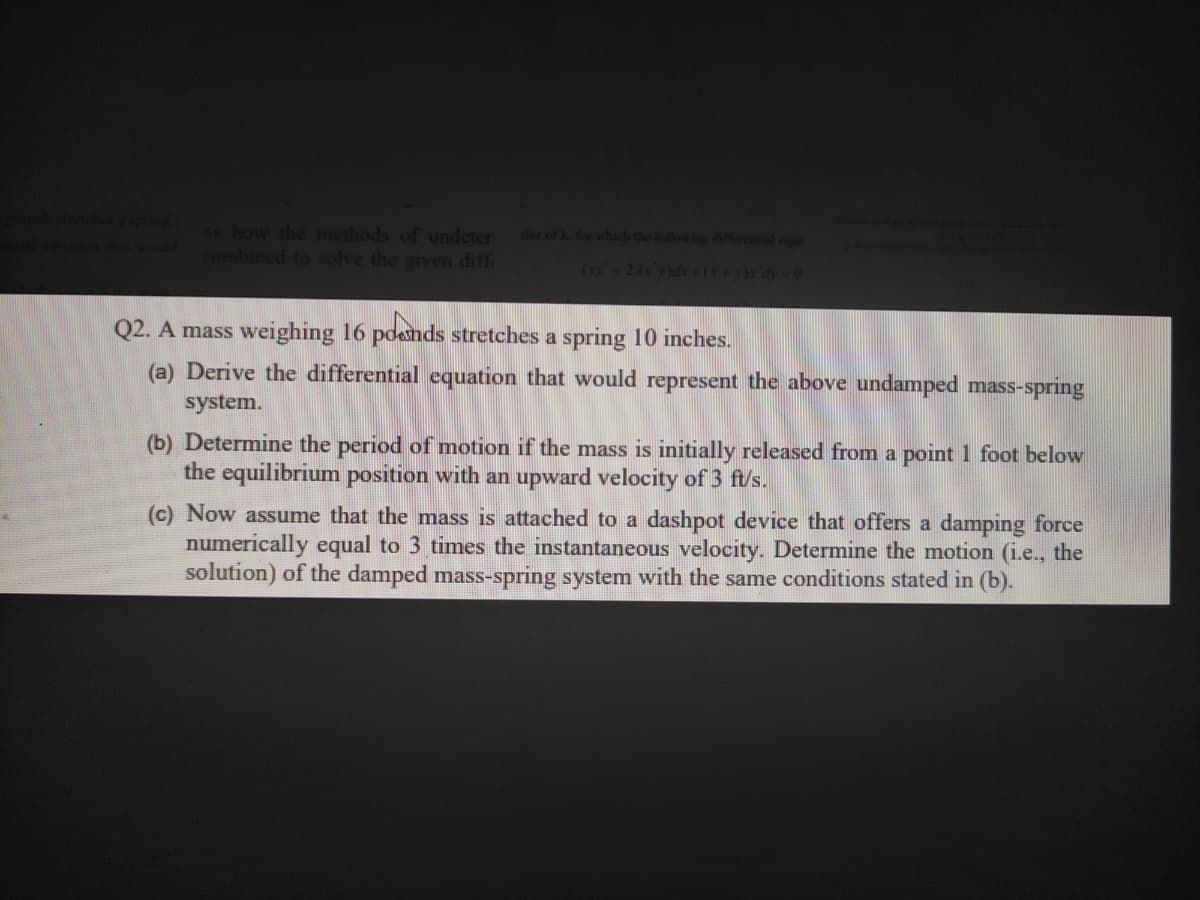A mass weighing 16 pdends stretches a spring 10 inches. (a) Derive the differential equation that would represent the above undamped ma system. (b) Determine the period of motion if the mass is initially released from a point 1 f the equilibrium position with an upward velocity of 3 ft/s. (c) Now assume that the mass is attached to a dashpot device that offers a damp numerically equal to 3 times the instantaneous velocity. Determine the motion soluti
A mass weighing 16 pdends stretches a spring 10 inches. (a) Derive the differential equation that would represent the above undamped ma system. (b) Determine the period of motion if the mass is initially released from a point 1 f the equilibrium position with an upward velocity of 3 ft/s. (c) Now assume that the mass is attached to a dashpot device that offers a damp numerically equal to 3 times the instantaneous velocity. Determine the motion soluti
Calculus: Early Transcendentals
8th Edition
ISBN:9781285741550
Author:James Stewart
Publisher:James Stewart
Chapter1: Functions And Models
Section: Chapter Questions
Problem 1RCC: (a) What is a function? What are its domain and range? (b) What is the graph of a function? (c) How...
Related questions
Question

Transcribed Image Text:spring
ss bow the methods of undeter
combined to solve the given difm
Se of . for which the following differeial cq
that would
Q2. A mass weighing 16 ponds stretches a spring 10 inches.
(a) Derive the differential equation that would represent the above undamped mass-spring
system.
(b) Determine the period of motion if the mass is initially released from a point 1 foot below
the equilibrium position with an upward velocity of 3 ft/s.
(c) Now assume that the mass is attached to a dashpot device that offers a damping force
numerically equal to 3 times the instantaneous velocity. Determine the motion (i.e., the
solution) of the damped mass-spring system with the same conditions stated in (b).
Expert Solution
This question has been solved!
Explore an expertly crafted, step-by-step solution for a thorough understanding of key concepts.
Step by step
Solved in 2 steps

Knowledge Booster
Learn more about
Need a deep-dive on the concept behind this application? Look no further. Learn more about this topic, calculus and related others by exploring similar questions and additional content below.Recommended textbooks for you

Calculus: Early Transcendentals
Calculus
ISBN:
9781285741550
Author:
James Stewart
Publisher:
Cengage Learning

Thomas' Calculus (14th Edition)
Calculus
ISBN:
9780134438986
Author:
Joel R. Hass, Christopher E. Heil, Maurice D. Weir
Publisher:
PEARSON

Calculus: Early Transcendentals (3rd Edition)
Calculus
ISBN:
9780134763644
Author:
William L. Briggs, Lyle Cochran, Bernard Gillett, Eric Schulz
Publisher:
PEARSON

Calculus: Early Transcendentals
Calculus
ISBN:
9781285741550
Author:
James Stewart
Publisher:
Cengage Learning

Thomas' Calculus (14th Edition)
Calculus
ISBN:
9780134438986
Author:
Joel R. Hass, Christopher E. Heil, Maurice D. Weir
Publisher:
PEARSON

Calculus: Early Transcendentals (3rd Edition)
Calculus
ISBN:
9780134763644
Author:
William L. Briggs, Lyle Cochran, Bernard Gillett, Eric Schulz
Publisher:
PEARSON

Calculus: Early Transcendentals
Calculus
ISBN:
9781319050740
Author:
Jon Rogawski, Colin Adams, Robert Franzosa
Publisher:
W. H. Freeman


Calculus: Early Transcendental Functions
Calculus
ISBN:
9781337552516
Author:
Ron Larson, Bruce H. Edwards
Publisher:
Cengage Learning